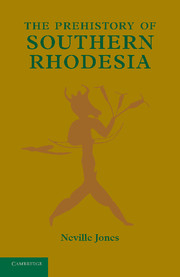Book contents
- Frontmatter
- Contents
- ILLUSTRATIONS
- Preface
- Note
- Chapter I Historical
- Chapter II The Earliest Men
- Chapter III The Building-up of the Rhodesian Sequence
- Chapter IV The Caves and Rock-shelters
- Chapter V The Rock Paintings
- Chapter VI The Ironstone Kopjes
- Conclusion
- Glossary
- References
- Index
- Miscellaneous Endmatter
Chapter VI - The Ironstone Kopjes
Published online by Cambridge University Press: 05 June 2016
- Frontmatter
- Contents
- ILLUSTRATIONS
- Preface
- Note
- Chapter I Historical
- Chapter II The Earliest Men
- Chapter III The Building-up of the Rhodesian Sequence
- Chapter IV The Caves and Rock-shelters
- Chapter V The Rock Paintings
- Chapter VI The Ironstone Kopjes
- Conclusion
- Glossary
- References
- Index
- Miscellaneous Endmatter
Summary
The ironstone kopjes present a problem peculiarly their own, and can hardly be dealt with in any other way than by considering them independently. There is evidence that goes to show that, wherever there are outcrops of ironstone, the suitability of this very hard rock for implement-making commended itself to early peoples. It is, however, with two localities only that we need to concern ourselves as they alone have received special attention, Gwelo and Hope Fountain.
(i) Gwelo Kopje. The kopje at Gwelo is a wellknown landmark and lies at the western end of the town itself. It has been extensively quarried for many years by the municipal authorities as a source of road metal, and, in view of the remarkable abundance of artificially chipped stones it contains, it has not inaptly been said that the town of Gwelo is paved with stone implements. The gravel is really a talus that has collected over a vast number of years and has consequently attained to a considerable thickness. It consists of smallish fragments of ironstone closely embedded together in a ferruginous sandy matrix. This site has long been known as a collecting ground for stone implements, and it early engaged the attention of Father Gardner, S.J., who made a large collection, which is now housed in St George's College, Salisbury.
It will be readily understood that the accurate sequential dating of stone implements in a talus is a very difficult task, but an attempt to accomplish this was made in 1932 by Fathers Gardner and Stapleton who devoted two weeks to it, and published their results(57). They excavated at the head of a trial pit previously opened up by Father Gardner at the base of the kopje, where, they stated, there was no observable stratification in the talus, through which they dug to a depth of 7 ft. At this depth they were forced to relinquish on account of the extreme hardness of the ground, which had become increasingly hard as they went down. They came to the conclusion that the material showed no signs of rolling and consisted of fragments of ironstone, partly natural and partly artificial in origin.
Owing to the nature of the ironstone it was observed that, when highly silicified, the implements retained their original sharp angles, but such was not the case where the material was softer.
- Type
- Chapter
- Information
- The Prehistory of Southern Rhodesia , pp. 68 - 72Publisher: Cambridge University PressPrint publication year: 2013



